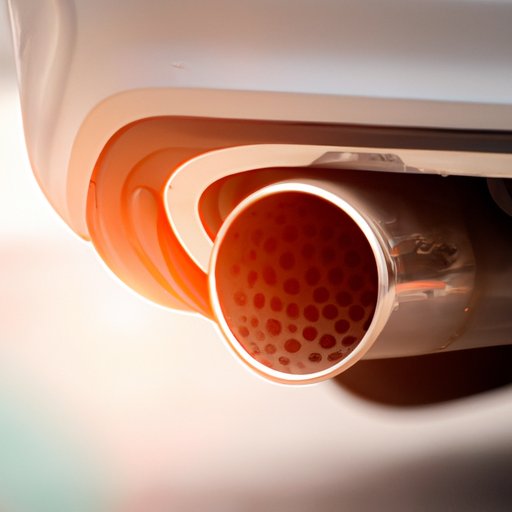Introduction
Car exhaust heat is an important factor to consider when it comes to vehicle performance and efficiency. It can have a direct impact on engine performance and fuel efficiency, as well as the environment. In this article, we will explore the science behind car exhaust heat, examining the factors that contribute to its heat and what temperatures are typically seen in different types of cars and engines. We’ll also take a look at the impact of car exhaust heat on performance and efficiency, as well as its effects on surrounding areas. Finally, we’ll discuss ways to mitigate the risk of high car exhaust temperatures.
Exploring the Science Behind Car Exhaust Heat
Car exhaust heat is generated by the combustion process that takes place within the cylinders of a car’s engine. The energy produced by the combustion of air and fuel is converted into mechanical energy that powers the car’s pistons. However, some of this energy is lost in the form of heat, which is then expelled through the exhaust system.
There are several factors that contribute to the heat of a car’s exhaust. These include the type of fuel used, the air-to-fuel ratio, the amount of compression in the cylinders, and the design of the exhaust system. All of these factors work together to determine the temperature of the exhaust gases.
How Hot Does a Car Exhaust Get? A Look at Temperature Ranges
The temperature of a car’s exhaust gases can vary greatly depending on the type of car and engine. Generally speaking, the exhaust temperature of a gasoline-powered car will be higher than that of a diesel-powered car. This is due to the fact that gasoline has a lower flash point than diesel, meaning that it combusts at a higher temperature.
The typical exhaust temperature range for a gasoline-powered car can range from 600°F to 1,200°F. For a diesel-powered car, the range is typically between 400°F and 900°F. Other factors such as the type of engine (turbocharged or naturally aspirated) and the size of the engine can also affect the exhaust temperature.
For example, a turbocharged engine typically runs hotter than a naturally aspirated engine, as the turbocharger forces more air into the cylinders, resulting in a higher combustion temperature. Similarly, larger engines tend to run hotter than smaller engines, as they require more fuel and air to create the same amount of power.

The Impact of Car Exhaust Heat on Performance and Efficiency
Excessively high exhaust temperatures can have a negative effect on engine performance and fuel efficiency. When exhaust temperatures become too hot, the engine is unable to transfer enough heat away from the cylinders, which can cause the engine to overheat. This can lead to engine knock, misfires, and other performance issues. It can also reduce fuel efficiency, as the engine will require more fuel to maintain performance.
High exhaust temperatures can also cause the catalytic converter to fail prematurely. The catalytic converter is responsible for reducing harmful emissions, and if it fails, it can drastically increase a vehicle’s emissions output.

Understanding the Effects of Car Exhaust Heat on Surrounding Areas
In addition to the problems it causes for engine performance and fuel efficiency, high car exhaust temperatures can also have a negative effect on the environment. Excessively hot exhaust gases can contain harmful pollutants, such as carbon monoxide and nitrogen oxides, which can be released into the atmosphere. These pollutants can contribute to air pollution and climate change.
High exhaust temperatures can also increase the risk of fire, as the exhaust gases can ignite nearby flammable materials. This can be especially dangerous in enclosed spaces, such as garages, where exhaust gases can build up and become highly concentrated.

How to Mitigate the Risk of High Car Exhaust Temperatures
Fortunately, there are several steps you can take to reduce the risk of high car exhaust temperatures. Regular maintenance is key, as worn parts and dirty filters can restrict air flow and cause the engine to run hotter. Additionally, it’s important to ensure that your cooling system is working properly and that the coolant levels are adequate.
It’s also a good idea to replace any worn parts that could be causing excessive exhaust heat. This includes the spark plugs, oxygen sensors, and exhaust manifold gaskets, as these components can all contribute to higher exhaust temperatures.
Conclusion
Car exhaust heat is an important factor to consider when it comes to vehicle performance and efficiency. In this article, we explored the science behind car exhaust heat, looking at the factors that contribute to its heat and the typical temperature ranges for different types of cars and engines. We also examined the impact of car exhaust heat on performance and efficiency, as well as its effects on surrounding areas. Finally, we discussed ways to mitigate the risk of high car exhaust temperatures.
(Note: Is this article not meeting your expectations? Do you have knowledge or insights to share? Unlock new opportunities and expand your reach by joining our authors team. Click Registration to join us and share your expertise with our readers.)
